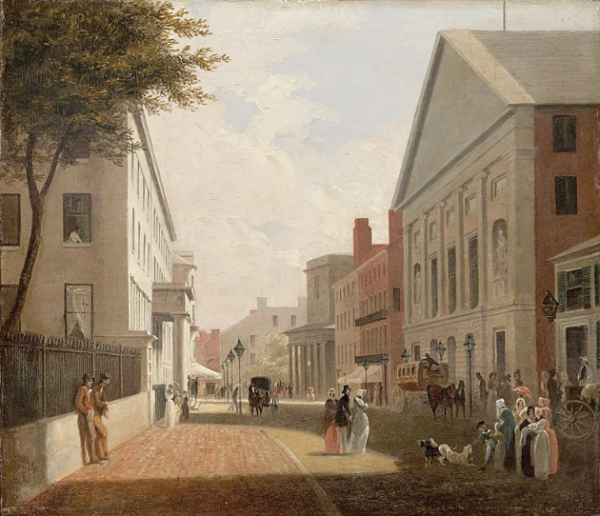February 29, 2024

From Stately Church to Status Symbol
On March 10, 1861, a throng gathered on Harrison Avenue to dedicate a new church for Boston’s growing population of Irish-Catholics and German-Catholics. Bishop John B. Fitzpatrick, the Irish immigrant and philanthropist Andrew Carney, and the chief architect, Tipperary-born Patrick C. Keely, figured prominently in the ceremony to celebrate the fruition of Father John McElroy’s mission to establish a church and eventually found a Jesuit college to provide education for Irish immigrants amid virulent ethnic and religious prejudice of 19th-century Boston.
The Church of the Immaculate Conception, and soon after a school that would evolve into Boston College, was rising above the South End.
Keely, a gifted architect whose work included Boston’s Cathedral of the Holy Cross and numerous other Catholic churches throughout Greater Boston and New England, rendered the Church of the Immaculate Conception in stunning white New Hampshire granite in a classic Renaissance Revival style.
Today, some 163 years later, another vision for the Harrison Avenue edifice has supplanted that of Father McElroy.Ddevelopers have turned the stately church into luxury residences.
Keeping an Eye on the Fenians
Controversy has erupted numerous times when it comes to Boston’s famed St. Patrick’s Day Parade. One clash came on March 17, 1876, the 100th anniversary of the day when cannon emplaced by George Washington’s rebel army drove the British Redcoats out of Boston for good. Discussions by the city legislature to enact an Evacuation Day observance met staunch opposition from Brahmins and Yankees who feared that the “ragged Irish” would twist such a holiday into debauched revelry under the cover of their patron saint’s name.
Despite that, the city’s Irish were determined to march in a St. Patrick’s Day parade, and march they did. The Boston Pilot (Volume 39, Number 12, March 18, 1876) hailed their “Grand Celebration in Boston,” noting “the affair will be entirely independent of the centennial celebration of Evacuation Day”
Among the many Irish organizations marching was an approximately 200-man Fenian contingent. The Fenians did pose a concern for the parade organizers, as well as the city writ large. Sworn to rid Ireland of British rule, a Fenian army composed largely of battle-hardened Irishmen from both the Union and Confederate ranks in the US Civil War had launched failed invasions of British-held Canada in 1866, 1870, and 1871. The Pilot reported: “The chief marshal has concluded that no organization illegally formed and bearing arms shall take part in the procession….”
At 10 a.m. on March 17, the Knights of St. Patrick gathered at 560 Broadway, the home of Chief Parade Marshal Major Lawrence J. Logan. The full procession paraded at noon on a route first to the State House to be reviewed by “His Excellency Gov. Rice and staff, and at City Hall by Mayor Cobb and city officials.”
John Boyle O’Reilly, a former Fenian firebrand, prisoner of the Crown, and now editor of the Pilot, was at that very moment was one of the plotters of the New Bedford whaling bark Catalpa’s rescue mission to break six Fenian soldiers from Fremantle Gaol in Western Australia.
A report in O’Reilly’s newspaper noted that Logan, perhaps daunted by the size of the procession, was supposed to host a banquet that evening, “but as he thinks he could not do justice in the way of accommodating all his friends, he has given up the project.”
A Gathering at the Temple
On March 4, 1878, some two years after that “Grand Celebration,” thousands of Boston Irish gathered at the Tremont Temple, a former theater that in 1843 had become a Free Baptist church and a key gathering place for Abolitionists. The March assemblage was there to celebrate the 100th birthday of the Irish rebel Robert Emmet, who, scant minutes after being convicted of high treason in a Dublin court in 1803, uttered the immortal words, “Let no man write my epitaph…”
James Jeffrey Roche, an unabashed admirer of O’Reilly, wrote that “the exercises at Tremont Temple” featured The Patriot’s Grave,” a poem by John Boyle O’Reilly. Scanning the spellbound crowd, awash in the poem’s final line –“That every patriotic life is the patriot’s epitaph” – O’Reilly paused. Then, his voice rising, he moved many in the Temple to tears: “A life such as his [Emmet’s] is never wasted. Often it is the price that is paid for justice.”
“With Goodwill Doing Service”
On St. Patrick’s Day 1887, the Charitable Irish Society of Boston celebrated the 150th anniversary of its founding (the likely site was the Parker House) and the embracing of its motto—“With Goodwill Doing Service.” One of the featured speakers was John Boyle O’Reilly, a man who had been accepted as a Charitable Irish member in December 1871. Joining him on the lectern was another rising star in the Boston Irish community – Patrick Collins, who would go on to become mayor of the city.
The Society’s 150th served in a sense as a showcase for two men who were proving how far the Irish had come since its members had first gathered in 1737. Still, as the words of O’Reilly and Collins reflected, the Boston Irish still faced a long, grueling path to acceptance among, in historian George W. Potter’s words, “the icicles of Yankee land.”
As Boston gears up for another St. Patrick’s “Marching Season,” it is fitting to remember the long and arduous march slog to 2024’s “Grand Celebration in Boston.”

